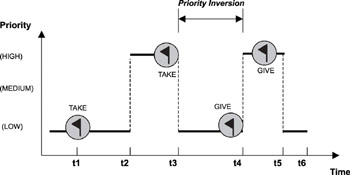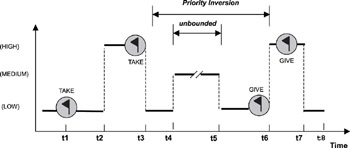Книга: Real-Time Concepts for Embedded Systems
16.4 Priority Inversion
Priority inversion is a situation in which a low-priority task executes while a higher priority task waits on it due to resource contentions.
A high task priority implies a more stringent deadline. In a priority-based, preemptive scheduling system, the kernel schedules higher priority tasks first and postpones lower priority tasks until either all of the higher priority tasks are completed or the higher priority tasks voluntarily relinquish the CPU. In real-time embedded systems, the kernel strives to make the schedulability of the highest priority task deterministic. To do this, the kernel must preempt the currently running task and switch the context to run the higher priority task that has just become eligible, all within a known time interval. This system scheduling behavior is the norm when these tasks are independent of each other. Task interdependency is inevitable when tasks share resources and synchronizing activities. Priority inversion occurs when task interdependency exists among tasks with different priorities.
Consider the situation shown in Figure 16.6, in which a higher priority task shares a resource with a lower priority task. The higher priority task must wait when the lower priority task has locked the resource, even though the higher priority task is eligible to run.

Figure 16.6: Priority inversion example.
As shown in Figure 16.6, at time t1 the low-priority task (LP-task) locks the shared resource. The LP-task continues until time t2 when the high-priority task (HP-task) becomes eligible to run. The scheduler immediately preempts the LP-task and context-switches to the HP-task. The HP-task runs until time t3 when it requires the shared resource. Because the resource is in the locked state, the HP-task must block and wait for its release. At this point, the scheduler context-switches back to the LP-task. Priority inversion begins at time t3. At time t4, the LP-task releases the shared resource, which triggers preemption and allows the HP-task to resume execution. Priority inversion ends at time t4. The HP-task completes at time t5, which allows the LP-task to resume execution and finally complete at time t6.
The priority inversion shown in Figure 16.6 is a bounded priority inversion. The duration of the low-priority task's holding time on the shared resource is known. It is possible for a medium-priority task to preempt the low-priority task for an undetermined amount of time, which would cause the high-priority task to wait indefinitely. This priority inversion scenario is called unbounded priority inversion and is shown in Figure 16.7.

Figure 16.7: Unbounded priority inversion example.
As in the previous example, priority inversion takes place at time t3. The low-priority task (LP-task) executes until time t4 when an unrelated medium-priority task (MP-task) preempts it. Because the MP-task does not share resources with either the HP-task or the LP-task, the MP-task continues execution until it completes at time t5. The duration between t4 and t5 is unknown because the duration depends on the nature of the MP-task. In addition, any number of unrelated medium-priority tasks can execute during this period. These unknown factors affect the interval and translate into unbounded priority inversion.
When priority inversion occurs, the execution times for some tasks are reduced, while others are elongated. In Figure 16.7, consider the case in which the high-priority task (HP-task) takes the guarding semaphore before the low-priority task (LP-task). The medium-priority task (MP-task) must wait until the HP-task completes. However, when the MP-task executes first, it is preempted by the HP-task. Again, the MP-task resumes execution after the HP-task completes. In both cases, the overall execution times for the MP-task are longer than the execution time to complete the MP-task during the priority inversion. Although some tasks are completed early, other tasks, such as the HP-task, might miss their deadlines. This issue is called timing anomaly introduced by priority inversion.
Priority inversion results from resource synchronization among tasks of differing priorities. Priority inversion cannot be avoided, but it can be minimized using resource access control protocols.
A resource access control protocol is a set of rules that defines the conditions under which a resource can be granted to a requesting task and governs the execution scheduling property of the task holding the resource.
Access control protocols are discussed in the following sections. These access control protocols eliminate the unbound priority inversion, and two of these protocols reduce the inversion time.
- 16.4.1 Priority Inheritance Protocol
- 5.5.5 Priority-aware mutexes
- 5.5.5.1 Priority ceiling mutexes
- 8.1.4 Beware of priority inversion
- SERVER PRIORITY CLASS
- Using Priority Scheduling and Control
- Setting the priority of individual documents
- 15.7.5 Sending High Priority Data between Tasks
- 16.4.2 Ceiling Priority Protocol
- 16.4.3 Priority Ceiling Protocol
- Работа с полем «Важность» письма («Priority»)




